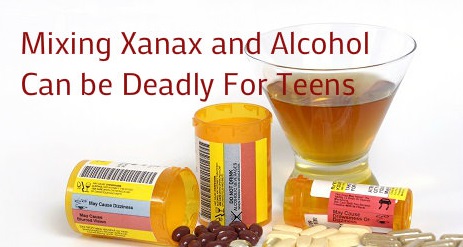Mixing Xanax and Alcohol Can be Deadly For Teens
If you look up the number one prescribed medication in the United States you will find Xanax at the very top of the list. The anti-anxiety medication is so widely prescribed these days that it can be found in a shockingly high number of American households. Used to treat anxiety and panic disorders, the drug is also commonly prescribed for patients complaining of high stress. Despite the fact that Xanax has recently been implicated in some high profile overdose deaths, the drug continues to enjoy widespread popularity.
Xanax is part of a family of drugs known as diazepines. Its chemical designation is Alprazolam and in 2009, 44 million prescriptions for the drug were written. By 2011 diazepine prescriptions were numbering above 260 million, of which Xanax represents the lion’s share.
Dangerous Quick High
Unfortunately the drug is not only popular with patients and their doctors but with young adults and teens looking for a quick drug-induced escape from reality. Teens like Xanax because it is so accessible – just grab one out of mom or dad’s medicine cabinet, right? – but also because the drug offers such a quick “high.” Within just 10 or 15 minutes users can feel an extreme high or low sensation. Users also experience accentuated symptoms of sedation like slurred speech, droopy eyes and other kinds of psychomotor retardation. Essentially, the person feels like they are drunk on alcohol.
Xanax provides a quick high because it is metabolized quickly, but the high ends just as fast as it comes on. The problem is that the drug also induces a state of memory impairment that is akin to blacking out. This creates a high risk situation since the person senses the absence of the sought after feelings but cannot remember that they recently took a pill, leaving them quite likely to pop another one. Taking even two Xanax in a short amount of time can have serious consequences.
Unfortunately, many who abuse Xanax also abuse alcohol. This means that users are taking two depressants at the same time. It is just like doubling up on Xanax in terms of risk. Drinking along with taking a Xanax may double the high, but it also ratchets up the risk factor – ingesting two strong depressants can slow down respiration (breathing) and the central nervous system to hazardously low levels.
Symptoms of Use
Symptoms of Xanax use include slowed heartbeat, trouble concentrating, slowed breathing, sleepiness, confusion and loss of memory. According to reports from the Substance Abuse and Mental Health Services Administration more than 60,000 hospital admissions were the result of Xanax abuse in 2008. Since prescription rates for the drug have steadily climbed by 9 percent annually, current figures can be expected to vastly outstrip that number.
Benzodiazepines like Xanax are medically appropriate when used to help epileptics prevent serious seizures. The drug is sometimes prescribed to treat insomnia but warnings abound recommending that the drug only be used short-term for treating sleeplessness. It is probably most commonly prescribed to calm symptoms of generalized anxiety disorder, but again the drug is recommended only for short-term use, not more than one month.
Xanax works by increasing activity of the brain’s own soothing mechanism. Neurotransmitters known as GABA are naturally occurring sedatives. When these neurotransmitters are abnormally excited long-term a physical and psychological dependence (addiction) can result.
What this means is that it is not hard at all for people using Xanax to quickly feel like they need the drug in order to cope. Tolerance is a term which describes how the body adjusts to the presence of medications and eventually requires more of a substance in order to produce similar results. Teens who take Xanax can wind up addicted to the drug before they know it.
If a teen is mixing Xanax – or any medication recreationally – with alcohol, the potential for addiction skyrockets, as does the risk of lethal consequences.




